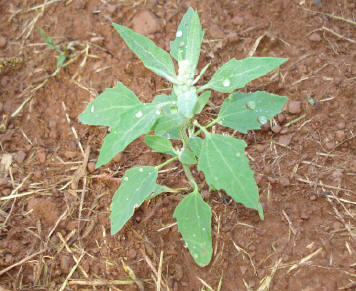Lee Royer
Frederick County Master Gardener
 Weeds are thieves in your vegetable garden. They rob your plants of moisture, nutrients, sunlight and growing room. Grass and mallows creep in from the lawn. Dandelions and docks sprout up from hidden roots. A multitude of green fuzzy seedlings suddenly sprout everywhere. If you didn't plant it,
odds are it's a weed. Now is the time to get control. To play with the old adage, "a stitch in time saves nine"- pulling one weed now saves pulling one nine times bigger next month or worse, years of future weeding if one goes to seed. The University of Maryland Master Gardener Handbook defines a weed as "any plant that
adversely affects the use, economic value, and aesthetic aspect of the lands and waters it infests".
Weeds are thieves in your vegetable garden. They rob your plants of moisture, nutrients, sunlight and growing room. Grass and mallows creep in from the lawn. Dandelions and docks sprout up from hidden roots. A multitude of green fuzzy seedlings suddenly sprout everywhere. If you didn't plant it,
odds are it's a weed. Now is the time to get control. To play with the old adage, "a stitch in time saves nine"- pulling one weed now saves pulling one nine times bigger next month or worse, years of future weeding if one goes to seed. The University of Maryland Master Gardener Handbook defines a weed as "any plant that
adversely affects the use, economic value, and aesthetic aspect of the lands and waters it infests".
Know thine enemy
Vegetable gardeners quickly recognize Maryland's common weeds but learning names and habits is even more helpful.
Weeds may be annuals, biennials or perennials. Knowing which is which will aid eradication efforts. Cutting or pulling tops of perennial weeds like dandelion (Taraxacum officinale), Narrow Leafed Plantain (Plantago lanceolata), or dock (Rumex crispus) may tidy the garden's appearance, but the plants are still there,
pulling moisture and nutrients away from your crops. As soon as possible new leaves will shoot out to compete for sunlight and space as well. To get rid of them for good you must kill or pull the whole root, typical for perennial weeds. Annual weeds send out thousands of seeds to sprout quickly in the warm June soil. Hoe
annual weeds such as pigweed (Amarathus retroflexus) and lambs quarter (Chenopodium album) when they are small, before they put down strong roots. Biennials have both traits for survival, so you will need to use both methods.
Control methods
 Keep bare soil covered with a layer of organic mulch such as straw, hay, grass clippings, or leaves. You will be surprised at how far this goes to prevent weed seeds from germinating and all but the most persistent perennials from reappearing. Those that do appear can be pulled or dug out. At the
same time you are enriching your soil as the mulch slowly turns into compost. An organic layer will also retain moisture to keep your plants more hydrated and cooler during our hot summers. You will need to replenish the layer as the summer progresses.
Keep bare soil covered with a layer of organic mulch such as straw, hay, grass clippings, or leaves. You will be surprised at how far this goes to prevent weed seeds from germinating and all but the most persistent perennials from reappearing. Those that do appear can be pulled or dug out. At the
same time you are enriching your soil as the mulch slowly turns into compost. An organic layer will also retain moisture to keep your plants more hydrated and cooler during our hot summers. You will need to replenish the layer as the summer progresses.
Synthetic mulches like black and colored plastics warm the soil quickly and are waterproof. Landscape cloth also warms the soil but allows water to penetrate the soil beneath. Synthetic mulches may be used for more than one season if handled carefully. Both are best placed over the rows before you
plant and then cut holes to place plants individually.
Hand-pulling and hoeing are time tested methods of weed control. When hand pulling weeds wear a sturdy pair of gloves and use a hand hoe or trowel. Pulling weeds is easiest after a good soaking rain. Many kinds of long hoes are available. The common or Dutch hoe is good for wide areas such as garden
paths or plots not yet planted. Pointed triangle shaped hoes or hoes with a small ends resembling an oversized razor blade are better for weeding between small vegetable seedlings. Keep all hoes sharpened for best results.
Other controls
In a small veggie garden you may closely space veggies to shade out weeds. Hand held flame tools are available to scorch the soil. Tilling, weed whacking, or mowing will kill some weeds and keep others from going to seed, critical because as the old saying goes "one year's seeding equals seven
year's weeding". Herbicides are the method of last resort. Choosing the wrong product and/or used incorrectly, herbicides will damage desirable plantings nearby, or worse, poison pets, children or you. Always read labels carefully and completely.
Read other articles on growing herbs or vegetables
Read other articles on gardening techniques
Read other articles by Lee Royer